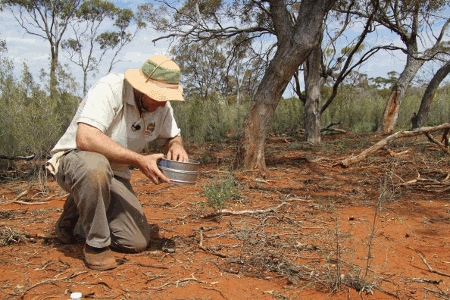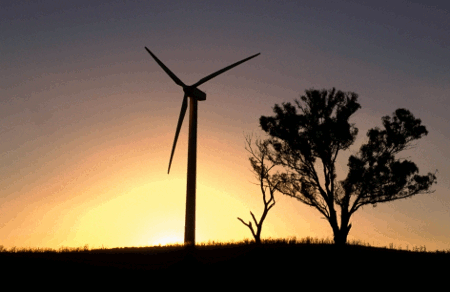
|
Published: 26 September 2011
Latest Bush Blitz digs up new finds in WA
New species of pseudoscorpions, trapdoor spiders and bees were among the discoveries made during a recent Bush Blitz at Credo, a former pastoral station in the Western Australian goldfields.

|
|
Mollusc expert Cory Whisson from the WA Museum searching for land snails in leaf litter at Credo Station. Credit:
Parks Australia
|
A team of scientists conducted the survey which is likely to significantly increase the number of known plant species at Credo Station, now managed by the Department of Environment and Conservation WA (DECWA) as part of the National Reserve System.
The new biodiversity data will be used in future management of the station.
Bush Blitz is a three-year, multi-million dollar partnership between the Australian Government, BHP Billiton, Earthwatch Australia, and AusPlots-Rangelands to document plants and animals in selected properties across Australia’s National Reserve System. The partnership harnesses the expertise of top scientists from museums, herbaria, universities, and other organisations.
Aboriginal trainees from DECWA joined the WA blitz to learn field survey techniques and familiarise themselves with semi-arid-zone reserves, which they help to manage across the Goldfields region.
For DECWA botanists, the 200 000 hectare property was a ‘goldmine’.
‘We got 540 plant collections, which we expect will significantly increase the 200 known species for Credo,’ said DECWA’s principal research scientist, Dr Neil Gibson.
‘We were on Credo at a peak time. The conditions are just perfect and a lot of plants have produced flowers and fruit, which will help us greatly in identifying the material we’ve collected.’
Dr Mark Harvey, an arachnid specialist from the WA Museum, said he found five or six species of pseudoscorpions – tiny scorpions without tails – which he suspects are new to science.
‘We also caught a number of species of trapdoor spiders which are likely to be new. This is one of Bush Blitz’s target species and we’re trying to survey them in every reserve we visit during the program,’ he said.
Remko Leijs, an expert in native bees from the South Australian Museum, collected at least 50 different bee species during the trip, a third of which he estimates will be new to science.
Another find was a quarry full of fossilised remains of ancient bee brood cells, probably belonging to ancient ancestors of a bee found only in Australia, according to Dr Leijs.
About 50 vertebrates – including five mammals, two frogs and a number of lizards and snakes – were also found on Credo during the blitz.
Earthwatch Executive Director Richard Gilmore said the expedition had been a great experience for participants from BHP Billiton, who had worked alongside the scientists to document and discover the new species.
Source: Bush Blitz/Parks Australia



